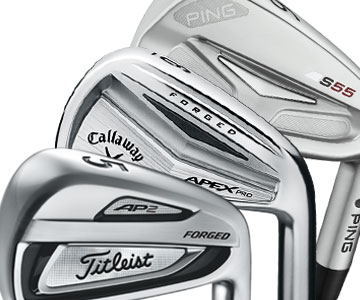| Is there such a thing as a ‘standard’ set of golf clubs in terms of length and loft?
The answer is yes and no. In the days of drivers with steel shafts and persimmon heads, the standard length for a driver was 43 inches. With the introduction of graphite shafts and titanium heads the new standard for drivers is 45+ inches. In terms of irons, in the 1970’s most golf manufacturers adhered to what was known at the 24/38 rule when it came to iron loft and length. That rule says that the average male golfer could be expected to hit a golf club with 24 degrees of loft and an overall length of 38 inches approximately 170 yards. Irons with a lower loft or a longer shaft was reserved for the very accomplished or elite players. In the 1970’s on average a 3 iron had 24 degrees of loft and was 38 inches long. Fast forward to today and despite the improvements in club heads, shafts and grips the 24/38 rule still applies. The average male golfer still hits a club with 24 degrees of loft and an overall length of 38 inches, 170 yards. What has changed is that the number assigned to the club has changed from a ‘3’ to a ‘5’. In terms of specifications, today it’s the 5 iron and not the 3 iron that has around 24 degrees of loft and an overall length of 38 inches. What caused this loft and length creep? In a word, marketing. The large golf club manufacturers found themselves in a very competitive situation and in an attempt to set themselves apart, manufacturers would produce clubs with claims of greater distance. Remember those ads that claim ‘our clubs are one club longer”, or “two clubs longer” than the competition? Well, they were not really one club longer. When you take a 7 iron and substantially decrease the loft and extend the shaft by up to an inch you have effectively turned it into a 6 iron and yes, 6 irons will go further than 7 irons. Between 1970 and the present most if not all club manufactures have strengthen the lofts, and extended the shafts on off the counter iron sets, effectively creating a new ‘standard’ in terms of iron loft and length. The table below shows how the loft and length of clubs has changed from 1970 to the present. The data in this table represents industry averages. There are some variations that fall outside the averages; for example the new Titleist AP1 irons start with a 19 degree 3 iron, as do the new Taylormade PSi irons, with more aggressive lofts throughout the set.
|
||||||||||||||||||||||||||||||||||||||||||||||||||
The next time you hear a commercial about irons that go further, check the lofts and lengths before you buy them. It might be much more economical to simply take a sharpie and write a different number on the bottom of your iron and perhaps lengthen the shaft by a half an inch, than buying into the hype and spending money on a new set.
Do you play golf in windy conditions? Try the Windcard.


The 9-iron lofts in the table are wrong. They should be between 8 and PW. Probably about 41-42 for a current set and 46 in the olden days.
LikeLike
Thank-you for pointing that out. Typos on my part. I have rectified it.
LikeLike
Good article. The current Ping G710 7 iron is 27.5 degrees. My 7 iron is 34 degrees. My 5 iron is 26 degrees. That a 20 metre difference not yards. Would be easier to fill in the number and engrave a distance on the bottom for an average golfer.
LikeLike
Agreed. The most important thing is that the individual golfer knows how far he/she hits a particular club regardless of what number is stamped on the bottom. For older golfers it is important to ensure that number is what is actually happening and not the distance we used to or would like to hit a particular club.
LikeLike
One also needs to take into account that modern irons have a much lower center of gravity which help get the ball up quicker. Also, with a lighter shaft you have to add length to keep the swing weight on the proper range. However, most of this is marketing hype. They have to figure it a way to say you can hit the ball farther since the promise of more distance sells.
LikeLike
The marketing madness continues!! New TM Stealth irons…9 iron is 37* @ 36.25”.
LikeLike
That is somewhat akin to the single length iron specs.
LikeLike